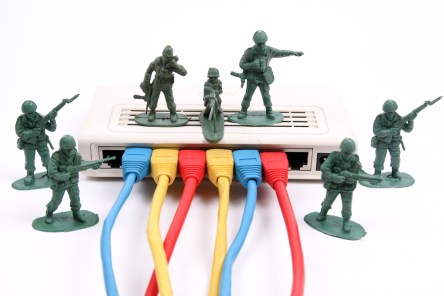What can Disney’s Beauty and the Beast teach us about smart homes and the impact of the Internet-of-Things on network security? At first glance, there doesn’t seem to be much of a connection between network security and a fairy tale about an enchanted castle, but a closer look reveals a surprising synergy. In a (mostly) tongue-and-cheek write up for Wired, Anna Vlastis argues that Disney’s live-action remake of one of their most celebrated films is nothing short of “a cautionary tale about the smart home.” Charmed Into Complacency It’s one thing to watch an animated teapot sing, quite another to see a live actor slip into its CGI rendering. As Vlastis points out, using humans to represent enchanted appliances makes the film “feel less like a workplace sitcom and more like dystopian novel.” Vlastis goes on to warn that consumers shouldn’t be fooled by the novelty of a “Stanley Tucci-voiced harpsichord.” These enlivened utensils hide a more sinister motive beyond entertaining musical numbers. Their anthropomorphism lulls us into complacency, allowing us to forget just what they are capable of. While Vlastis plays this insight for laughs, she makes a valid point. Our smart homes are vulnerable precisely because we underestimate the capabilities of our wired toasters and internet-enabled lightbulbs. In the wrong hands, these devices provide an easy entryway for hackers and ne’er-do-wells. “Over the last few years, we’ve been connecting anything and everything we can to the internet under the guise of simplicity,” writes Lifehacker’s Thorin Klosowski. “Security with IoT devices is so bad that when we hear about a hacked IoT device, we generally release a large collective shrug. This isn’t a huge deal yet, but it’s going to be.” “We’ve brought this stupid future on ourselves.” Surveillance through Passive Consent With...
Stranger Danger
Cyber Security 2017
In many ways, 2016 will be known as the year of the hack. Between Russian Hackers, DDoS attacks bringing down the eastern seaboard, or the little matter of over a billion compromised Yahoo! Accounts, last year marked the moment “cyber” security went mainstream. While there’s no doubt more of the same is on the way, Wired has put on its prognostication cap to ponder what new security threats will emerge over the next 12 months. After all, as they say, forewarned is forearmed. “It’s hard to know for certain what lies ahead, but some themes began to present themselves toward the end of 2016 that will almost certainly continue well into next year,” begins Wired. “…the more we can anticipate them, the better we can prepare.” Dawn of the Drones Military drones have been fighting proxy battles across the globe for quite some time now, but private, commercial drones could soon turn deadly. Though they’re smaller than their battle-worn counterparts, commercial drones have existed in an unregulated, wild west-type no-man’s-land. Though the FCC currently requires drone owners to register their devices, internationally, there’s little oversight. Wired reports small drones have already been used for terrorist activities and guerrilla warfare, including an attack on US-allied Kurdish soldiers in October of last year. “What better way to deliver deadly ordnance across enemy lines or into secure zones of cities than with remote-controlled accuracy and off-the-shelf hardware that offers no easy way to trace the perpetrator,” Wired asks. “The US government is already buying drone-jamming hardware. But as with all IEDs, the arms race between flying consumer grade bombs and the defenses against them will likely be a violent game of cat-and-mouse. iPhone goes to Court Wired predicts the conflict between federal authorities and mobile-phone providers, which hit...
Rogue Routers
Smart Home Security
The smart home’s weakest link may be that unassuming router tucked neatly next to your modem. [Update: Netgear has released firmware updates for the affected products. Click here for more information.] While the breach of one billion Yahoo! Email accounts continues to dominate the new, another internet security crisis continues unabated. As Lily Hay Newman reports in Wired’s latest issue, Nighthawk line of Netgear routers can be remotely exploited, allowing third-parties to take control of the devices, leaving thousands of home networks open to hackers and “”havoc-wreaking botnets.” “While Netgear has finally released a tentative fix for some models,” writes Newman, “the delays and challenges in patching all of them help illustrate just how at risk the Internet of Things is—and how hard it is to patch up when things go wrong.” Hacking the Home Like many of the smart devices that make up the “Internet of Things,” routers seem as common – and as low-tech – as a toaster or thermostat. But as has already been noted, the ubiquitous nature of many of these ‘wired” versions of our beloved devices make them almost invisible; and for many smart home inhabitants, invisibility is a weakness. “If we want to put networked technologies into more and more things, we also have to find a way to make them safer,” Michael Walker, program manager and computer security expert for the Pentagon’s advanced research arm recently told the New York Times. “It’s a challenge for civilization.” Routers Gone Wrong Andrew Rollins, a security researcher with the handle Acew0rm, notified Netgear about the security flaw back in August but never heard back from the company. As months went by with no fix – presumably exposing thousands of users in the interim – Rollins eventually chose to go public....



